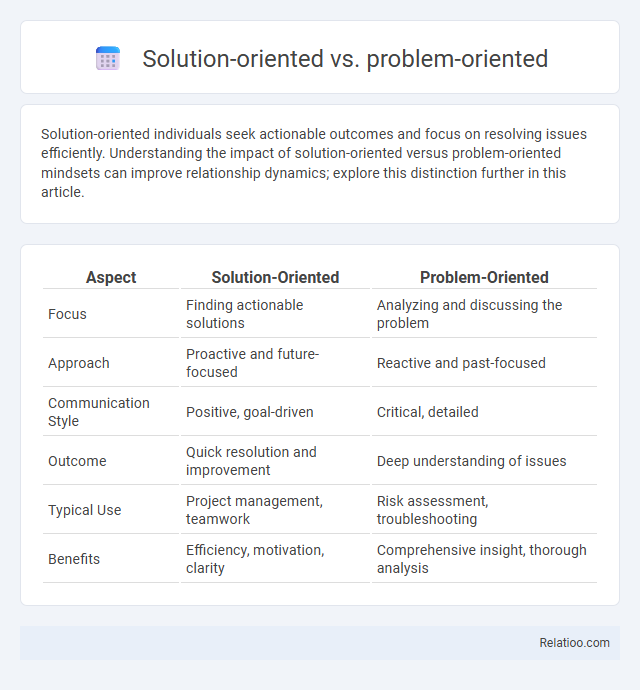Solution-oriented individuals seek actionable outcomes and focus on resolving issues efficiently. Understanding the impact of solution-oriented versus problem-oriented mindsets can improve relationship dynamics; explore this distinction further in this article.
Table of Comparison
| Aspect | Solution-Oriented | Problem-Oriented |
|---|---|---|
| Focus | Finding actionable solutions | Analyzing and discussing the problem |
| Approach | Proactive and future-focused | Reactive and past-focused |
| Communication Style | Positive, goal-driven | Critical, detailed |
| Outcome | Quick resolution and improvement | Deep understanding of issues |
| Typical Use | Project management, teamwork | Risk assessment, troubleshooting |
| Benefits | Efficiency, motivation, clarity | Comprehensive insight, thorough analysis |
Understanding Solution-Oriented and Problem-Oriented Approaches
Solution-oriented approaches emphasize identifying actionable steps to address challenges, fostering proactive problem resolution and forward-thinking strategies. Problem-oriented approaches focus on analyzing issues in depth to understand root causes, which aids in developing comprehensive solutions grounded in thorough evaluation. Understanding the distinctions between these methods enhances decision-making by balancing immediate actions with strategic problem analysis.
Key Differences Between Solution-Oriented and Problem-Oriented Thinking
Solution-oriented thinking emphasizes identifying actionable steps to resolve issues, fostering proactive decision-making and innovation. Problem-oriented thinking dwells on analyzing obstacles, which can lead to comprehensive understanding but may slow progress due to excessive focus on challenges. Key differences include solution-oriented approaches prioritizing forward momentum and practical outcomes, while problem-oriented approaches focus on in-depth problem analysis and risk assessment.
Benefits of Adopting a Solution-Oriented Mindset
Adopting a solution-oriented mindset empowers your decision-making by emphasizing actionable steps rather than dwelling on obstacles, leading to increased productivity and faster problem resolution. This approach fosters resilience and innovation, as it encourages looking beyond issues to explore creative alternatives and opportunities for improvement. Embracing solution-orientation enhances collaboration and communication, enabling teams to focus on shared goals and drive successful outcomes.
Common Drawbacks of Problem-Oriented Approaches
Problem-oriented approaches often lead to stagnation by fixating on obstacles rather than opportunities, which can cause prolonged negative focus and decreased motivation. This mindset may limit creativity and hinder your ability to identify innovative solutions, resulting in repetitive problem cycles. Emphasizing solutions enhances proactive thinking, encourages constructive action, and fosters progress toward desired outcomes.
How Solution-Focused Strategies Improve Productivity
Solution-focused strategies improve productivity by directing attention toward actionable steps and positive outcomes rather than dwelling on problems. This approach encourages proactive behavior, reduces time spent on obstacles, and fosters a results-driven mindset that enhances efficiency. Organizations adopting solution-oriented methods experience faster decision-making and increased employee motivation, leading to higher overall performance.
When to Use Problem-Oriented Analysis
Problem-oriented analysis is most effective when identifying root causes of complex issues in your business processes or systems, allowing targeted interventions. Use this approach when data highlights recurring challenges that require thorough investigation before implementing solutions. Prioritizing problem-oriented analysis ensures that solutions address the underlying issues rather than just symptoms, improving overall efficiency and outcomes.
Real-World Examples: Solution vs. Problem Orientations
Solution-oriented approaches emphasize actionable strategies to resolve challenges, exemplified by companies like Toyota, which uses the Kaizen method to continuously improve manufacturing processes. Problem-oriented methods prioritize identifying and understanding issues, as seen in investigative journalism where deep analysis uncovers systemic problems before proposing reforms. Real-world effectiveness often depends on balancing both orientations, such as in healthcare, where diagnosing causes (problem-oriented) leads to tailored treatments (solution-oriented) that improve patient outcomes.
Tips for Shifting from Problem-Focused to Solution-Focused
Shifting from a problem-focused to a solution-oriented mindset requires embracing strategies such as reframing challenges into actionable goals, practicing positive inquiry, and fostering a future-oriented perspective that emphasizes possibilities instead of obstacles. Techniques like setting clear objectives, brainstorming potential solutions, and engaging in reflective questioning help individuals break free from the limitations of problem analysis. Cultivating resilience and adopting solution-focused language can transform workplace dynamics, boost productivity, and enhance emotional well-being by promoting proactive problem-solving approaches.
The Role of Mindset in Effective Problem Solving
Mindset plays a crucial role in effective problem solving by determining whether an individual adopts a solution-oriented or problem-oriented approach. A solution-oriented mindset emphasizes proactive strategies, creativity, and resilience, fostering quicker resolution and innovation. In contrast, a problem-oriented mindset tends to fixate on obstacles, which can hinder progress and reduce the efficiency of finding viable solutions.
Choosing the Right Approach: Solution-Oriented or Problem-Oriented?
Choosing the right approach between solution-oriented and problem-oriented strategies depends on the context and desired outcomes. A solution-oriented approach emphasizes actionable steps and positive outcomes, driving innovation and efficiency, while a problem-oriented approach focuses on thoroughly understanding and diagnosing the issue to avoid superficial fixes. Balancing these methods ensures comprehensive problem-solving by addressing root causes and implementing effective solutions.

Infographic: Solution-oriented vs Problem-oriented
 relatioo.com
relatioo.com